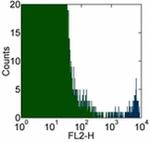Search Thermo Fisher Scientific
Invitrogen
FceR1 alpha Monoclonal Antibody (AER-37 (CRA1)), Functional Grade, eBioscience™
FIGURE: 1 / 2
FceR1 alpha Antibody (16-5899-82) in Flow


Product Details
16-5899-82
Species Reactivity
Published species
Host/Isotype
Recommended Isotype Control
Class
Type
Clone
Conjugate
Form
Concentration
Purification
Storage buffer
Contains
Storage conditions
Shipping conditions
RRID
Product Specific Information
Description: The AER-37 monoclonal antibody reacts with the Fc epsilon RI alpha subunit, an IgE-binding subunit lacking signal-transducing ability. Fc epsilon RI apha is expressed on mast and basophil cells and is upregulated by the presence of IgE. Fc epsilon RI alpha forms a tetrameric complex with one beta and two gamma subunits. The beta and gamma subunits possess immunoreceptor tyrosine-based activation motifs (ITAM). The Fc epsilon RI complex plays an important role in triggering IgE-mediated allergic reactions.
Applications Reported: This AER-37 (CRA1) antibody has been reported for use in flow cytometric analysis and functional assays (such as stimulation of basophil migration).
Applications Tested: This AER-37 (CRA1) antibody has been tested by flow cytometric analysis of peripheral blood cells. This can be used at less than or equal to 1 µg per test. A test is defined as the amount (µg) of antibody that will stain a cell sample in a final volume of 100 µL. Cell number should be determined empirically but can range from 10^5 to 10^8 cells/test. It is recommended that the antibody be carefully titrated for optimal performance in the assay of interest.
Storage and handling: Use in a sterile environment.
Filtration: 0.2 µm post-manufacturing filtered.
Purity: Greater than 90%, as determined by SDS-PAGE.
Endotoxin Level: Less than 0.001 ng/µg antibody, as determined by LAL assay.
Aggregation: Less than 10%, as determined by HPLC.
Target Information
FceR1 (Fc epsilonR1 alpha) is a subunit of the high affinity receptor of IgE. Fc epsilonR1 alpha is a tetrameric complex consisting of one alpha, one ß and two additional subunits. The latter two are required for signal transduction activity. The Fc epsilonR1 complex plays an important role in triggering allergic responses, and the immunoglobulin epsilon receptor (IgE receptor) is the initiator of the allergic response. When two or more high-affinity IgE receptors are brought together by allergen-bound IgE molecules, mediators such as histamine, which are responsible for allergy symptoms, are released. The IgE receptor couples allergen and mast cells to initiate the inflammatory responses that are characteristic of disorders such as hay fever and asthma. The release of histamine and proteases leads to the synthesis of prostaglandins and leukotrienes-potent effectors of the hypersensitivity response.
For Research Use Only. Not for use in diagnostic procedures. Not for resale without express authorization.
Bioinformatics
Protein Aliases: fc epsilon r1; Fc epsilon receptor Ia; Fc epsilon RI alpha-chain; Fc fragment of IgE, high affinity I, receptor for; alpha polypeptide; Fc IgE receptor, alpha polypeptide; Fc-epsilon RI-alpha; FcERI; high affinity immunoglobulin epsilon receptor alpha-subunit; High affinity immunoglobulin epsilon receptor subunit alpha; IgE Fc receptor subunit alpha; immunoglobulin E receptor, high-affinity, of mast cells, alpha polypeptide; RP11-550P17.3
Gene Aliases: FCE1A; FCER1A; FcERI
UniProt ID: (Human) P12319
Entrez Gene ID: (Human) 2205

Performance Guarantee
If an Invitrogen™ antibody doesn't perform as described on our website or datasheet,we'll replace the product at no cost to you, or provide you with a credit for a future purchase.*
Learn more
We're here to help
Get expert recommendations for common problems or connect directly with an on staff expert for technical assistance related to applications, equipment and general product use.
Contact tech support
